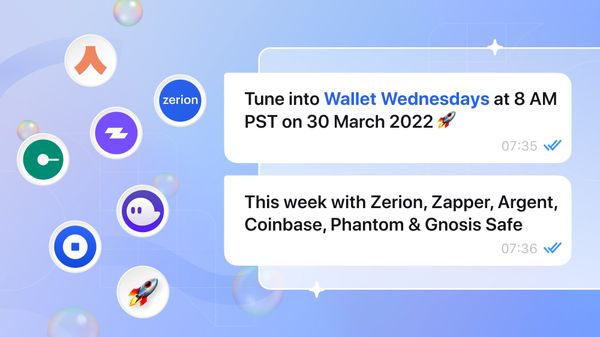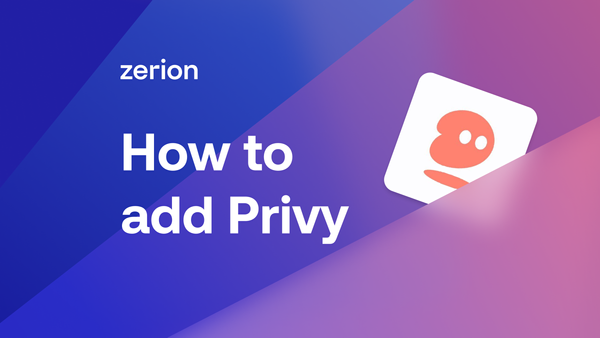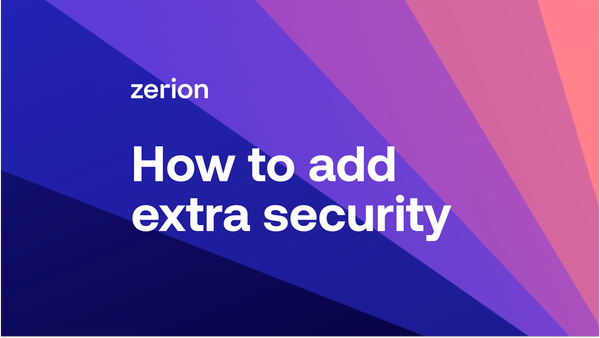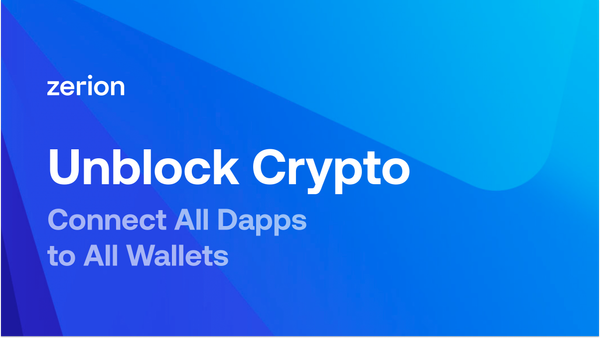Wallet Wednesdays are a weekly conversation hosted in Zerion’s Twitter Spaces to discuss the evolution of non-custodial wallets.
For the second meeting, we’ve gathered an outstanding group of people:
- Rebecca Mqamelo, Head of Growth at Zerion
- Evgeny Yurtaev, CEO at Zerion
- Brian Friel, Developer Relations Evangelist at Phantom
- Jorge Selva, Marketing Lead at Gnosis Safe
- Chintan Turakhia, Director Of Engineering at Coinbase Wallet
- Matt Marshall, Engineering Lead at Argent
- Abishek Dharshan, Head of Community at Zerion
- Oops, Community Wizard at Zapper
Crypto wallet security: approaches and new ideas
Security is one of the most important aspects of any crypto wallet and that was the first focus of the discussion.
Owners of non-custodial crypto wallets can’t just ring their bank if something goes wrong, Jorge Selva, Marketing Lead at Gnosis Safe, explained. A future where losing your seed phrase means losing all your funds is not a viable future.
To deal with this paradigm shift, Argent started with the idea of having a smart contract multisig with timelocks and looking at how a user can be protected in real-life events. Argent approaches this by having a ‘guardian’ that can help to recover the funds. That could be a hard wallet, a trusted family member or friend, or a combination of those.
We believe that having a single key as a point of failure is problematic.
"We approach this through the social recovery side: it’s essentially multi-auth user or ownership of an account. This could be a gnosis safe that has multiple signers or a combination of a Ledger plus a MetaMask or whatever else it could be.
This addresses the threat vector. Instead of having a single set of keys, you need multiple keys to unlock an account.
It’s also important to educate both individual and enterprise users on the importance of private and public keys and how to safely store them. Everybody must understand the risks of storing all eggs in one basket."
Evgeny Yurtaev, CEO of Zerion, explained how Zerion manages multiple seed phrases and private keys:
"The yet unreleased Zerion wallet is a pure seed phrase-based wallet. We decided to go ahead with the type of wallet that has the most traction.
One of the biggest considerations for us was the ability to use a wallet across different chains, which makes a big difference for the new audiences who are coming into the Web3 space.
And we also wanted to have the ability to manage multiple seed phrases within a single app so that you don’t have to jump between different apps to sign transactions."
Browser extensions have become a common attack vector even for advanced users. Phantom is a newer crypto wallet, built specifically for Solana just a year ago. And in that short time frame, they onboarded millions of users.
Brian Friel explained how Phantom approaches security:
"A lot of Phantom users are not that experienced and NFTs are one of the biggest use.
So the whole time you know our motto has been: How can we make Phantom safe, easy, intuitive, and approachable?
And so one of the big things that we've been seeing on Solana are time-sensitive NFT drops. This means that security has to be really easy for users, otherwise they're going to just take a screenshot of their seed phrase or something else that might cause damage later."
While seed phrases remain the dominant way to secure non-custodial assets, there have to be ways to manage those. And Brian outlined Phantom’s new feature:
"One of the things that we just launched is seamless one-click integration with 1Password. So if a new user sees their seed phrase, they can just click a button and it will be stored with encryption in 1Password. They don't have to worry about writing that down."
Yet most people are entering crypto through centralized, custodial exchanges like Coinbase.
Chintan Turakhia, Director Of Engineering at Coinbase Wallet, offered their perspective on managing seed phrases in a crypto wallet:
"There is a trade-off between abstracting out the complexity of seed phrases versus minimizing risk to the user.
The seed phrases are one of the most important elements in a non-custodial wallet.
And there is a risk that you can abstract it out so much that the user won't understand the importance of that seed phrase.
So for example, in the US banks will hold USD. And if something happens and they lose our money, the banks are supposed to pay us back up to a certain amount.
That’s not how it works in crypto. Many new users don’t understand that."
As a result, education is extremely important for welcoming new users. Building quests and onboarding experiences are crucial. Yet it shouldn't stop there, we should continuously remind users that seed phrases and private keys are important, Chintan said.
This education can also happen in a gamified environment that simulates a fully non-custodial experience. Start with a centralized exchange experience, then interact with Web3 in a custodial environment, and finally graduate to a fully non-custodial experience.
Monetizing crypto wallets
New wallets are all vying for mass adoption of crypto. And wallets are already becoming the primary interfaces that people use to invest in DeFi and NFTs.
So what should monetization look like for a wallet?
For a long time wallets were not considered viable business models, Brian Friel noted. For example, in 2012, Jesse Powell, co-founder and CEO of Kraken Exchange, was choosing between starting a crypto wallet and a crypto exchange — and he has made the right decision.
Now there is an understanding that a wallet can be a serious business mode, Brian says, and that’s what Phantom is experimenting with:
"I don't think there's anything wrong with monetizing a wallet because users expect their wallets to be world-class.
Essentially, it's their most used touchpoint when navigating with the space. They want to know that there's a serious company behind that has longevity and a real path to sustainable revenue.
One of the things that we do is have a swapper in our wallet that does charge a small fee.
However, in Web3 we can't just rest on our laurels. Capital can move freely in the space and if our swapper isn't giving users the best deal, they can go somewhere else."
It's still early days and crypto wallets are relatively well-funded organizations, so there's always the promise of a sustainable revenue source in the future, Matt Marshall of Argent said.
Matt added:
"I think that owning the user experience layer is the best place to capture value over time.
This could be either via making user journeys simpler and within a mobile app. For example, let's say swapping tokens. So we do take a transparent small swap fee similar to some of the other wallets. Here we do not take a fee on buying crypto through an onramp provider.
We see that it's a fair trade-off if we've made something simpler for the user. But we're not blocking the user from going through a different protocol, so there is an opt-in.
Security features could also be another potential revenue stream. There are also opportunities with all of the different types of applications that wallets can interact with."
Chintan Turakhia said that in addition to fiat onramp fees or fees for DEXes or swaps, there are probably some revenue streams that are yet to be built. For example, in the future dapps might be choosing wallet partners because of safety, security, and simplicity for their users.
The portability of assets and identity in Web3 is what makes competition strong across all different applications, Jorge Selva added. Crypto wallets are incentivized to do what's best for their users.
Gnosis, however, does not currently monetize. Instead, Gnosis is focusing on creating a better incentive structure for builders and developers to create great use case-specific applications built on top of the Gnosis Safe.
Abishek Dharshan of Zerion has raised a question about use cases for community-based monetization beyond freemium or transactions.
Microtips could be one way, Oops, Community Wizard at Zapper, suggested. Microjobs, buying and selling, and other opportunities for the community could later lead to monetization for the wallet.
Getting 1% of 100 people's efforts is more beneficial to everybody vs 100% of your own efforts.
Crypto wallets 20 years from now
The secession wrapped with a question about how crypto wallets will look in the far, far future.
All the speakers had some fascinating ideas about how crypto wallets could evolve.
- Evgeny Yurtaev, Zerion: The wallet merged with hardware. Think blockchain phone, which fully runs on decentralized tech. This could be a way to break down the current monopolies.
- Rebecca Mqamelo, Zerion: The convergence of crypto wallets and biography. Imaging signing a transaction by scanning your iris.
- Matt Marshall, Argent: Decentralized web will be just ‘web’ and dapps will be just ‘apps’. There will be a lot less friction and it will be easier to interact with any application.
- Jorge Selva, Gnosis: Portable identity can lead to fascinating use cases such as participating in real-world governance with a wallet.
- Abishek Dharshan, Zerion: Gym membership is a token. Your insurance card is a token. Any transactional use case could be considered a token.
- Chintan Turakhia, Coinbase: Onchain experiences become credentials and demonstrate skills and experiences, potentially even replacing job interviews.
Given all these different directions, in 20 years crypto wallets might not even be known as wallets.
What’s next for Wallet Wednesdays
Stay tuned for our next Wallet Wednesdays on 6 April 2021 at 8 AM PST. We'll focus on lessons learned in building wallets: user research and collaborative building with the community.




